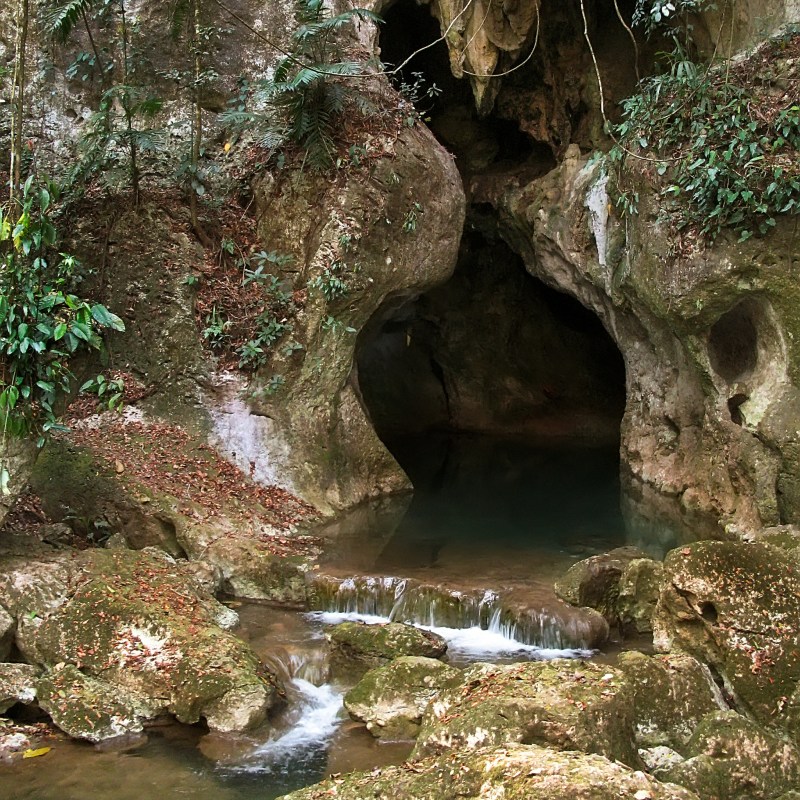
I stared down at the dead boy and wondered what his name was. He lay on his back, his arms bent in an angle away from his spine that I could see embedded into the cave floor. His short leg bones extended forward, but I couldn’t see his feet, if, indeed, they were there at all.
Videos by TravelAwaits
The eye sockets of his skull peered upwards, forever gazing at the towering ceiling of the cave that his Mayan people believed was the entrance to the underworld and lair of the gods.
The boy (or girl), maybe aged 16 according to archeologists, glittered in crystals, his skeleton bathed by centuries of calcite deposits from the swell and sighs of the river that runs through this still-living grotto.
I gazed down and felt a sharp pang of envy for his strange immortality.
This poor shimmering boy, a sacrifice to the Mayan rain god Chac, is among the 14 human sacrifice remains found so far in the Actun Tunichil Muknal cave (sometimes referred to as ATM) deep in the heart of the Tapir Mountain Nature Reserve in western Belize.
I was in there with my travel buddy Amey, and we booked our tour with Kawiil Tours through the Bocawina Rainforest Resort in the Mayflower Bocawina National Park, just a short drive from Dangriga.
I’m obsessed with exploring caves, so the Actun Tunichil Muknal was high on our must-do list.

The Skeleton (And The History Of ATM)
The skeleton was nicknamed The Crystal Maiden back when it was believed to belong to a young girl; scientists are now debating whether or not the maiden was actually male.
Of the 14 souls left in the underworld as offerings to relieve the drought that played a role in the fall of the Mayan Empire, six were children under the age of three.
“This was a big offering to sacrifice a child,” said Ian, our cave guide with Kawiil Tours. “It would have been a big decision for the parents, but the ultimate sacrifice to the gods.”
Laying in the dark since around 580 A.D., this boy now has his own worshippers. According to the Belize Audubon Society, Actun Tunichil ATM was discovered in 1989 but had been known to the locals for years before. In 1989, Dr. Jaime Awe convinced local men to guide him to a cave they said was filled with Mayan artifacts, but he was never credited with “discovering” it because the locals were aware of it first.
Dr. Awe continued to study the cave with his Western Belize Regional Cave Project. Teams of explorers and scientists mapped the ATM throughout the 1990s, and scientists found their treasure a quarter-mile below the surface — the Crystal Maiden, the skeleton of a youth covered in calcite.
ATM was a sacred place for the Mayas, and archeologists believe the cave was used during the Classic period from 250 to 909 A.D. According to Ian, each major Mayan city had its sacred cave which served as the entrance to the underworld and the gods.
Rain was a lifeblood, but also a threatening force for the Mayans. The great towering ancient cities built in Belize, Guatemala, and Honduras had required the clear cutting of the rainforest, and in the ninth century, that decimation of the forests called forth the wrath of Rain God Chac. He held back the rains. Cities dwindled out. As Mayanist Richardson Gill set forth in his research in 2000 when he studied sediment cores from area lakes, tree rings, and soil, the severe drop in rainfall may have been a major factor in the demise of the once-powerful, once-stupendous Maya society.
The gods were angry. They demanded sacrifice, and at the ATM cave, those sacrifices still remain in nearly the same condition as they were left centuries ago. Vessels hand-created from clay and filled with spices, food, incense, and dark, seductive chocolate were ceremoniously broken as offerings to the gods.
The deeper inside the cave the pots lay, the harder the sacrifice. When incense and food didn’t appease the angry Chac, blood was offered next.
The human sacrifices were not easy. Like Ian said, the harder the death, the greater the sacrifice. Some were bludgeoned to death. Others had their hands and feet chopped off and were left to slowly bleed out. Others, perhaps my sparkling boy included, had their heart removed while they were still alive.

Heide Brandes
The Challenges Of Getting To The Underworld
It’s a challenging journey into the underworld, but worth it for a glimpse into the past. The hike to Actun started with a swim across Roaring Creek at the edge of the Tapir Mountain Nature Reserve. A yellow rope stretched across the river, and as I slipped into the water, tiny minnows charged in to nibble at my toes and neck.
The swim wasn’t a hard one, but the water was cold enough to trap the breath in my throat, and I couldn’t help but laugh at the adventure of it all.
We crossed the Roaring Creek twice more in the 30-minute hike to the cave, and we were the lucky ones. The path and the picnic areas at the trailhead were built in 2010. Before, visitors and guides would hack through the jungle from wherever their vehicles got stuck in order to reach the cave entrance. One guide would stay behind to try to get the vehicle unmired while the others used machetes to clear a path through the jungle.
Today, the hike is an easy, flat trail that parallels the river, but part of me longed for the experience of bush-whacking my way to the underworld.
“Okay, we swim again,” Ian said as the dark yawn of the ATM opened before us. “Be careful of the rocks. It’s very slippery where the sun still shines in.”

Heide Brandes
Throughout most of the cavern, my friend Amey and I swam. In other places throughout the cave, we scrambled over and between boulders and walls, careful not to touch the formations and glittered flowstone that poured down the towering ceilings.
To enter the main chamber is to leave your shoes behind.
“Step where I step, touch where I touch,” Ian said.
Dangers To Be Aware Of
We had beat the big groups behind us that showed up on a giant bus, so it felt like Amey, Ian, I, along with two intrepid older adventurers, had the cave to ourselves. We swam through narrow passages, climbed sheer cave walls, and tripped over submerged rocks.
I thought how an experience like this would never fly in the U.S.; it seems too dangerous for the public, especially the rickety ladder tied haphazardly with ropes that one had to climb barefoot to reach the inner chamber to view the offerings.
In this cave, no guide rails protected the clumsy from a fall and no electric lights beamed the safe path. Here, you took your chances of falling or twisting delicate ankles, and I earned a few “cave kisses” as my knees slammed into unforgiving and jagged limestone.
Barefoot, we continued on into the belly of the gods.

The sheer number of pots, dark and brown pottery of all sizes, was staggering. Early explorers say more than 1,400 pots were found just laying in plain sight in the flowstone pools, visible to the naked eye with no need for excavation. Thousands more are likely buried under layers of calcite, each one begging Chac for “rain, rain, please bring the rain.”
We all slinked along the ridges of the pool, inches away from artifacts that had survived for centuries in the dark.
“Look down,” said Ian.
It took me a second to realize I was staring down at a skull, its yellowed jaw missing its two front teeth like some cheerful toddler. Several years before, a photographer’s long lens knocked the teeth out as he bent over too far for that perfect picture.
Above and past the ladder of doom, another skull laid face down. A large hole in the back of the skull made me think this soul was bludgeoned, but I was wrong.
A man, holding his own and his wife’s digital camera, had struggled for a couple of shots, and he accidentally dropped his wife’s camera, which burst through the cranium.
For the powers that be in Belize, that was nearly the last straw. Terrified of the continued damage to the relics and remains, the government planned to close the cave, but the official guides begged and pleaded, and a compromise was made.
No photos. No cameras. No gear. So far, that rule has worked, and no other major incidents of damage have occurred since, Ian said.
“This is our livelihood,” he said. “We fought to keep the cave open for tours. We go through a long training to become guides. It’s an honor.”
Staring at my crystallized boy, it was an honor for me to be in the dark with him, to remember him in some small way for what he gave up to try to save his people.
His death wasn’t enough for Chac. The rains didn’t come. Massive cities were left abandoned for the jungle to reclaim, and his people scattered defeated and lost across Belize, Honduras, Guatemala, and Mexico.
But still, The Crystal Maiden remains silent and still and glowing under the eyes of tourists curious for a glimpse of immortality. For me, the dangers of the underworld were worth the chance to slip back into history and honor the dead.

Heide Brandes
Pro Tips
You must have a registered guide to enter the ATM Cave. We recommend Kawiil Tours or Maya Walk, the first tour company allowed inside the cave. You will receive all the necessary equipment, including cave helmets and lights, from your guide, but you should wear sturdy shoes for the hike to the cave.
The cave does require some swimming and some climbing, so if you have mobility issues, this could be a challenge. Do not touch anything, and step only where your guide steps.
Again, all caves carry inherent risks for injury, so make sure you are physically able to climb steep, slippery areas, swim through relatively shallow underground rivers, and not have a problem with close, confined spaces.
You will not be allowed to carry cameras or cell phones inside the cave, but be sure to take a change of clothes with you for after the tour. Captivated by archeological sites? Read up on
- Where To See Petroglyphs In the United States
- Beyond Chichen Itza: Maya Ruins In The Yucatan Worth Visiting
- Things To Know About Visiting Monte Alban In Oaxaca
- 7 Tips For Visiting Chichen Itza, Mexico
- 6 Amazing Historic Sites To Experience On Kos, Greece
- How To See Pompeii And Herculaneum In A Single Day
- 8 Reasons To Visit Ayutthaya In Thailand
